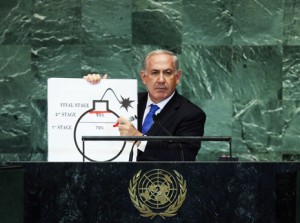In making his case against Iran in his United Nations speech, Benjamin Netanyahu held up a crude graphic intended represent an Iranian bomb. The Israeli Prime Minister drew a line with a red marker to emphasize the urgent need for action against the Islamic Republic and sound the alarm bells.
Instead, the rendition of an “Iranian bomb” that Bibi chose to make his case–which most likely would earn no more than a C if submitted as a fourth grade science project– is eliciting giggles and guffaws, inviting comparisons with the Acme devices used in Road Runner cartoons, the rules for which (provided below) may be more applicable to Israel and Iran than one would first think.
 Robert Mankoff of the New Yorker launched a caption contest for the photo of Bibi and his bomb sketch. As of this writing, Mankoff has received 164 online entries. Mankoff’s own contribution to start it off: ”And, what’s worse, if Wile E. Coyote ever gets hold of this, the Roadrunner is toast.”
Robert Mankoff of the New Yorker launched a caption contest for the photo of Bibi and his bomb sketch. As of this writing, Mankoff has received 164 online entries. Mankoff’s own contribution to start it off: ”And, what’s worse, if Wile E. Coyote ever gets hold of this, the Roadrunner is toast.”
Jon Stewart of the Daily Show, after sardonically skewering both Iranian President Mahmoud Ahmadinejad and President Barack Obama for their speeches in a segment dubbed Bore Games, asks, “Isn’t anybody going to give us the red-meat rhetoric and pop comedy we’ve come to expect from the United Nations?” There’s a cut to Netanyahu, drawing his red line. “Bibi, bubby, what’s with the Wile E. Coyote nuclear bomb?” Stewart asks. “Are you gonna pretend you don’t know what a nuclear bomb looks like? You’re Israel! Go downstairs and look in the basement!”
Even the Atlantic‘s Jeffrey Goldberg, plenipotentiary pundit on the Iranian threat to Israel, tweeted that “Netanyahu didn’t even draw his Wile E. Coyote red line in the right place” opined that Netanyahu had trivialized and undercut whatever point he thought he was making:
Netanyahu shouldn’t have waved around that cartoonish drawing on the podium of the United Nations. It made him look unserious, and a man in his position can’t afford to look unserious. I’m hearing ridicule of that stunt from people in the United States government who are a) militant on the subject of Iran, and b) needed by Israel to carry-out effective anti-proliferation efforts. Don’t confuse massive press coverage of his ACME bomb chart with approval of his ACME bomb chart. A non-Wile E. Coyote chart with a red line would have been more useful than this.
ComPost blogger Alexandra Petri asked in the Washington Post:
Was this a poor choice of a ridiculous-looking, over-simplified bomb cartoon, created decades before the invention of the Internet by someone who had a limited understanding of bombs? Or was it a calculated choice of a ridiculous-looking, over-simplified picture, created decades before the invention of the Internet by someone with a limited understanding of bombs — in order to create the one indelible image of the afternoon that everyone would be talking about?
But maybe Netanyahu was indeed sending a message about the strategic logic behind Israel’s relationship with Iran.
In his book Chuck Amuck: The Life and Times Of An Animated Cartoonist, Chuck Jones suggests that he and the other artists behind the Road Runner and Wile E. cartoons adhered to some simple but strict rules. As identified and enumerated on Wikipedia, these rules are:
1. The Road Runner cannot harm the Coyote except by going “meep, meep.”
2. No outside force can harm the Coyote — only his own ineptitude or the failure of Acme products. Trains and trucks were the exception from time to time.
3. The Coyote could stop anytime — if he were not a fanatic. (Repeat: “A fanatic is one who redoubles his effort when he has forgotten his aim.” — George Santayana).
4. No dialogue ever, except “meep, meep” and yowling in pain.
5. The Road Runner must stay on the road — for no other reason than that he’s a roadrunner.
6. All action must be confined to the natural environment of the two characters — the southwest American desert.
7. All tools, weapons, or mechanical conveniences must be obtained from the Acme Corporation. There were sometimes exceptions when the Coyote obtained other items from the desert such as boulders to use in his attempts.
8. Whenever possible, make gravity the Coyote’s greatest enemy (e.g., falling off a cliff).
9. The Coyote is always more humiliated than harmed by his failures.
10. The audience’s sympathy must remain with the Coyote.
11. The Coyote is not allowed to catch or eat the Road Runner.
Reading these rules carefully, and substituting Israel for Road Runner and Iran for Wile E. Coyote, it’s difficult not to conclude that (with the exception of #10, since Iran receives no sympathy from anyone) the Israeli Prime Minister has indeed chosen an apt image–what looks like an Acme bomb straight out of a Road Runner cartoon to describe a relationship that seems to follow the same rules: “No dialogue ever” and “The Coyote is not allowed to catch or eat the Road Runner.” There’s at least one rule Netanyahu would like to change–the one about “no outside force” being able to harm the Coyote.
Perhaps when President Barack Obama told Steve Kroft of Sixty Minutes
When it comes to our national security decisions, any pressure that I feel is simply to do what’s right for the American people. And I am going to block out any noise that’s out there”
the noise he meant was “meep! meep!”?





Chuck Jones would be proud of you, Marsha.